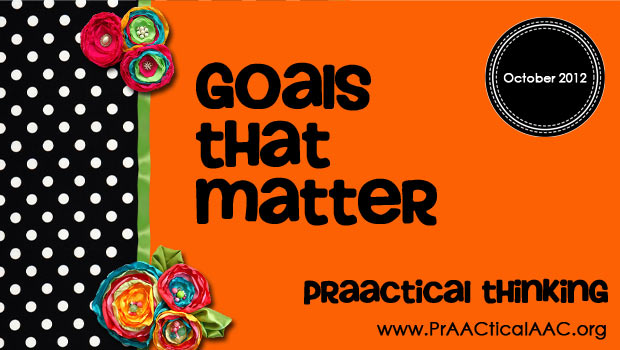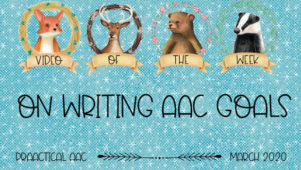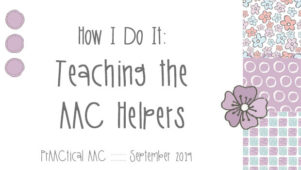PrAACtical Goals That Matter

Like some of you, we often get asked “The Question.” People sometimes ask us to give them a recommendation about what AAC device or app is best for a particular individual. When the question comes from a parent or therapist whom we don’t know, it’s understandable. But when it is from a clinician we’ve taught, (who should know better), it’s a bit baffling. Obviously, we’d never make that kind of recommendation without having done an evaluation, or at least reviewing someone else’s assessment. We dread “The Question.”
On the other hand, there are a lot of things that we wish people would ask that relate to how to help the communicator develop strong skills. This post relates to to one of those type of questions. “What should I work on?” “What kinds of AAC goals should we write?” We like those kinds of questions and our answers generally have one consistent theme: Write goals that matter.
Goals That Matter
To us, here’s what writing Goals That Matter means.
- Goals That Matter DO address skills that make the communicator happier or more independent.
- Goals That Matter DO teach things that enable the communicator to be a more efficient learner.
- Goals That Matter DO provide a strong foundation for further language development.
- Goals That Matter DO positively influence how other people treat the communicator.

- Goals That Matter DON’T address a skill just because the communicator missed it on a test/ evaluation instrument.
- Goals That Matter DON’T teach something just because it is part of a goal sequence that someone developed for a generic program.
- Goals That Matter DON’T assume that because someone hasn’t mastered ‘early skills’ that ‘later skills’ are out of the question.
We don’t pretend to have all the answers in writing goal writing in AAC. Not by a long shot. But we do have some experience with this issue and, more importantly, the opportunity to gather together some collective wisdom from all of you out there doing the work. So, consider this an invitation: Please join us is developing a set of goals that young clinicians or those relatively new to AAC can use as a resource. Even experienced AAC clinicians may enjoy browsing them. As clinicians, we are frequently inspired by the exchange of ideas and the fresh perspective that offers.
How Do I Get Involved?
- Go to PrAACtical Goals That Matter, a collaborative document on Google Drive.
- Browse. We’ve started the list off with 100 ideas for AAC goals.
- Add any that you wish, but please follow the DO’s and DON’Ts that we listed above.
- If you’d like to be acknowledged as a Contributor, add your name. This is completely optional.
- If you have difficulty modifying the document, send them to us by email (addresses in the document) and we’ll take it from there.
LINKS
Editable document on Google Drive: http://bit.ly/UNldrE
PDF for printing on Dropbox: http://bit.ly/UNkWEV
Feel free to pass this invitation on to others whose perspective on AAC you value and respect. Hopefully, we will end up with a list of meaningful goals that we can browse to use when we need some new ideas. Thanks in advance for any prAACtical input you can give.
—
Filed under: PrAACtical Thinking
Tagged With: collaboration, goal bank, goal setting, goals, objectives
This post was written by Carole Zangari





8 Comments
A great idea!
This is a bit off the subject, but I’m wondering if you have information that would help me develop an assessment protocol for students that may benefit from using an iDevice.
Rosaline, there is no single protocol but we listed several resources in this post: http://bit.ly/WdvS1d. We also use the AAC Eval Genie app & a test called the TASP. If you are familiar with the feature match process, it is basically the same with an iDevice. If not, let us know and we will try to round up some info on that for you.
What an awesome idea!!!!!! I don’t have anything to add right now, but can already see myself using this at future IEP meetings! Please post drafts as they come along so I can pin (that’s how I remember where to find things!).
Thanks for following and using AAC goals. We definitely will post updates as they are ready. We will ‘pin’ them as well.
What type of goals do you suggest for academic areas and AAC users?
Gina, students who use AAC are an incredibly diverse group so it would be hard to list goals that would work for all or even most of them. As a rule, I try to stick as closely as I can to the general education curriculum and pull a lot from the language arts standards for their grade level. Even for students with significant disabilities we can often extract a core element from the standards and wrap our goals around that kernel.
My son uses AAC, he is also highly motivated by electronics so iPad becomes a frequent reinforcer. And given that he is in middle school, he has accessto a device like all the other students, PLUS, the teacher uses the Smart Board as a teaching aide? Just wondering, when does toomuch screen time become a problem? Also, can I ask for my son not to have any screentime during school hours? If I can, how will I ever know that my request was honored since I am not in school and he cannot tell me?
Thank you.
Judith, thanks for your questions. The use of electronics for communication is very different than other uses of ‘screen time.’ Studies that have come out looking at ‘screen time’ have not included AAC but rather the use of these devices for recreation and entertainment. Using a SmartBoard to project the AAC display allows your son and his classmates to see competent models of aided communication as the teachers, aides, and therapists use it to communicate, and this is generally very beneficial. We support approaches like this that normalize AAC use and make it more acceptable in the classroom and elsewhere.